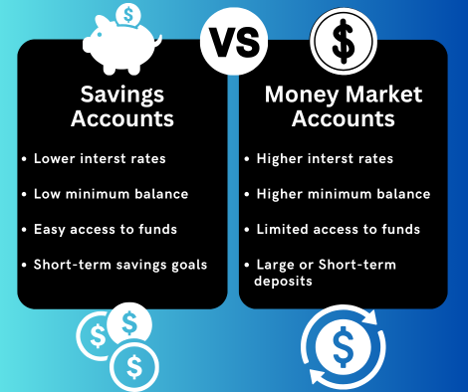
When it comes to building financial security, one of the most important steps you can take is choosing the right place to keep your money. At Utah Independent Bank (UIB), we know that every financial decision matters—and that includes understanding the difference between a traditional savings account and a money market account (often called an IMMA, or interest-bearing money market account).
While these two accounts might seem similar at first glance, they serve slightly different purposes and can impact your financial growth in unique ways. In this post, we’ll break down the key differences, explain the benefits of each, and help you decide which option—or combination of both—works best for your personal financial goals.
Why Knowing the Difference Matters
Many people treat savings accounts and money market accounts as interchangeable. While both are designed to store money securely while earning interest, the features, accessibility, and best-use cases differ.
Understanding these differences can:
- Help you maximize your interest earnings.
- Provide the right level of flexibility and access.
- Support your short- and long-term savings goals.
- Give you confidence in how you’re managing your money at UIB.
What Is a UIB Savings Account?
A UIB savings account is a secure, reliable place to grow your money while keeping it easily accessible. It’s ideal for people who want a straightforward way to earn interest on funds they don’t plan to spend daily but still want available for emergencies or upcoming expenses.
Key Features of UIB Savings Accounts
Safety and Security
- Insured up to the FDIC limit, giving you peace of mind that your deposits are protected.
Earn Interest on Your Balance
- While rates can vary, your money grows steadily without risk.
Easy Access
- Withdrawals can be made in person, at ATMs, or through online banking.
- Designed for occasional use, not daily transactions. Customers are allowed five withdrawals each quarter without a penalty
Low Opening Requirements
- UIB savings accounts are simple to open and maintain, making them accessible for families, students, and anyone just starting their savings journey.
Best Use Cases
- Emergency Fund: Keep three to six months of living expenses in your savings for unexpected events.
- Short-Term Goals: Save for vacations, holiday shopping, or a new appliance.
- Safe Starting Point: Perfect for first-time savers or younger individuals learning about personal finance.
What Is a Money Market Account (IMMA)?
A money market account (IMMA) combines features of a savings account with some of the flexibility of a checking account. Think of it as a hybrid that allows you to earn competitive interest rates while also writing checks or using a debit card.
Key Features of UIB IMMA Accounts
Higher Interest Rates
- Typically, money market accounts offer better rates than traditional savings accounts, rewarding you for keeping higher balances.
Limited Transaction Capability
- Federal guidelines often limit the number of withdrawals or transfers per month. UIB allows for five withdrawals/transfers each month
Tiered Interest
- At UIB, your earnings may increase as your balance grows, making this account a smart option for larger deposits.
Security and Insurance
- Like savings accounts, UIB’s IMMA accounts are FDIC insured.
Best Use Cases
- Large Emergency Funds: Keep substantial savings accessible while maximizing interest.
- Major Purchases: Perfect for funds earmarked for buying a home, car, or education costs.
- Short-Term Investments: Provides higher earnings without the volatility of the stock market.

Comparing UIB Savings Accounts and Money Market Accounts*
Which Account Is Right for You?
The answer depends on your goals, lifestyle, and financial situation.
Choose a UIB Savings Account If…
- You’re just starting to save.
- You want easy, no-frills access to your money.
- You’re building an emergency fund.
- You prefer low opening requirements.
Choose a UIB Money Market Account If…
- You have a larger balance and want to earn more interest.
- You don’t need daily access to your money.
- You want limited check-writing privileges.
- You’re saving for big purchases or future investments.
Use Both Together for Maximum Benefit
Many UIB customers find that using both accounts in combination works best:
- Savings Account: for your starter fund and immediate needs.
- Money Market Account: for higher balances you don’t touch often but still want accessible.
This dual approach allows you to build discipline, keep cash liquid, and earn higher returns where possible.

Real-Life Examples
Example 1: Building an Emergency Fund
Sarah is just starting her career. She opens a UIB savings account with $500 and adds $100 each month. Over time, she builds a cushion of $3,000 for unexpected expenses.
Example 2: Saving for a Home Down Payment
John and Emily already have a $10,000 savings cushion. They open a UIB IMMA account to save an additional $20,000 for a house down payment. With higher interest earnings, they reach their goal faster while keeping the funds safe.
Example 3: Family Budgeting
A family keeps three accounts at UIB: a checking account for bills, a savings account for holiday expenses, and a money market account for a large emergency fund. This structure helps them stay organized and maximize their earnings.

Personal Finance Tips for Using Savings and Money Market Accounts
Choosing the right account is just one piece of the financial puzzle. Here are some personal finance tips to help you make the most of your UIB accounts:
1. Automate Your Savings
- Set up automatic transfers from checking to savings or IMMA so you’re consistently building your balance.
2. Keep Savings Separate from Spending
- Resist the temptation to dip into savings by keeping your accounts separate from your everyday spending.
3. Review Your Accounts Regularly
- Monitor balances, interest earned, and transaction limits to avoid unnecessary fees.
4. Use Tiered Interest to Your Advantage
- If your IMMA offers higher rates for larger balances, consider consolidating savings to reach the threshold.
5. Revisit Your Goals
- Every six months, evaluate whether your accounts align with your goals—vacations, retirement, or emergency readiness.
6. Combine with Other UIB Services
- Pair your savings or IMMA with UIB’s checking accounts, CDs, or loans for a complete financial picture.
Why Choose UIB for Your Savings and Money Market Accounts?
At Utah Independent Bank, we’re more than just a place to deposit your money. We’re a trusted community partner dedicated to helping Utah families, businesses, and individuals build financial confidence.
When you open a UIB savings account or money market account, you’ll enjoy:
- Local Service: A team that understands Utah families and businesses.
- Competitive Rates: Designed to maximize your hard-earned money.
- Trusted Security: FDIC insurance and decades of community banking expertise.
- Convenient Access: Online and mobile banking, ATMs, and in-branch support.
Whether you’re saving for emergencies, investing in your future, or planning for a big purchase, UIB is here to guide you every step of the way.
Final Thoughts
A UIB savings account and a money market account (IMMA) both serve as powerful tools in your personal finance toolkit. The key difference lies in how you plan to use your money: savings accounts are perfect for building a foundation, while money market accounts help you maximize returns on larger balances.
By choosing the right account—or combining both—you’ll be on your way to smarter financial management and long-term success.
Ready to get started? Visit the UIB Savings Accounts page or stop by your local UIB branch to open an account today.
*Rates and Fees are subject to change without notice. Please consult the bank or local branch for the most current information.
This article is for educational and informational purposes only and does not constitute financial advice. Product features, fees, and terms may change and may vary by account type or location. Please refer to the official account disclosures and terms provided by the bank for complete and up-to-date details before making any financial decisions.
Disclaimer: The views and opinions expressed in this post do not necessarily reflect the official policy or position of Utah Independent Bank. This post is intended for entertainment and/or informational purposes only and should not be construed as financial advice or an endorsement of any product or service.


